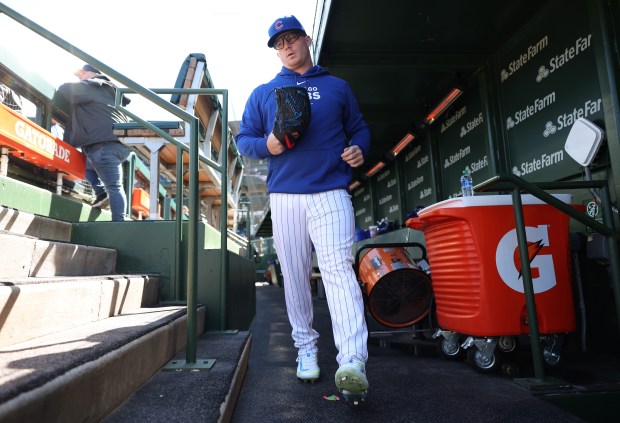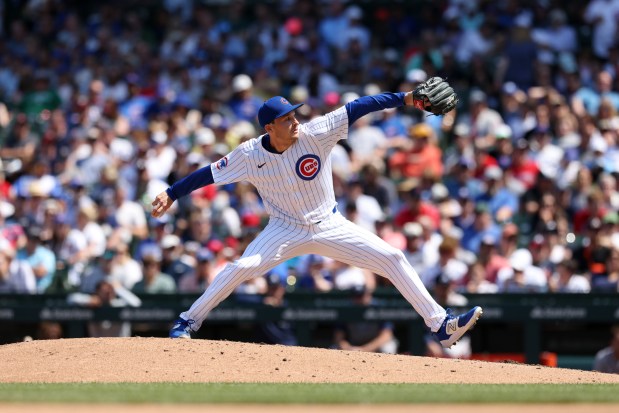The development of Ben Brown, Hayden Wesneski and Jordan Wicks could be one of the more important pieces of the pitching puzzle this summer for Chicago Cubs manager Craig Counsell.
All three young pitchers have bright futures as major-league starters, but with the Cubs rotation set in the first four slots, adjustments have been made for the good of the team.
Both Brown, 24, and Wesneski, 26, have started and pitched out of the bullpen in the first 2½ months of the season, while Wicks, 24, made his first relief appearance Saturday after rehabbing at Triple-A Iowa from a left forearm strain.
Brown currently holds the No. 5 spot in the rotation and has performed well with a 3.23 ERA in eight starts, averaging 9.9 strikeouts per nine innings with a 0.97 WHIP. His seven no-hit innings against the Milwaukee Brewers on May 28 was the most dominant performance this year by a Cubs pitcher and gives reason to believe he’ll get every opportunity to stick in the rotation the rest of the season.
But Brown said he’ll do whatever Counsell feels is best and doesn’t have any problems adjusting on the fly.
“Whichever way I’m impacting the team best is OK,” he said. “I’m just grateful to be here. Just take it with an open hand and make sure I stay on top of my routines and my recovery. This is the first time I’ve (gone back and forth). It’s cool.”
Brown had a brutal major-league debut March 30 in Texas, allowing six runs in 1 2/3 innings after entering in the seventh. Since then he has a 2.68 ERA in 14 appearances with 63 strikeouts in 53 2/3 innings.
Obviously there’s a difference between knowing when you will pitch every week and sitting in a bullpen wondering if you’ll get in that day.
“It’s a little mental and a little physical,” Brown said. “There’s every aspect you have to check off when it comes to the mentality of pitching out of the bullpen and pitching as a starter. There are a lot of differences.
“I think it’s easier to bring a reliever’s mentality into the starting rotation than a starter’s mentality into the bullpen. It’s just a matter of acknowledging that (difference).”
Wesneski has a 2.20 ERA in three starts and a 3.32 ERA in 13 relief outings. Like Brown, he had no previous relief experience until last year with the Cubs, when he switched roles after beginning the season in the rotation and being demoted to Iowa.
Wesneski said the biggest challenge is variations in his workout schedule because he wants to do enough running and lifting on days he doesn’t get to pitch.
“Starting, it’s very scheduled,” he said. “These five days, I’m doing this, this, this and this. I always throw every day. I probably should start taking a day off or so, but the amount of stuff you do (working out) is the difference.”
Like Brown, Wesneski said the mental side of the switch is something he’s learning about on the job.
“You have to be able to calm your nerves and use them,” he said. “The first two innings I don’t need to be nervous. I should be enjoying the game, talking to the guys, feeling things out with the lineup, kind of feel how the game is going. And once the game starts ramping up, that’s when I should start paying attention to the routine and figure out, ‘OK, where am I going to pitch again?’ And be ready. Then you start getting a little nervous, and it happens.
“You have to be able to turn it on and shut it off. Starting, you only have one day of it, so you’re off, off, off, off, all the nerves are gone.”
Wesneski pitched on back-to-back days for the first time last week in the City Series against the White Sox, serving up a home run in both appearances. He has allowed four homers in his last seven outings. Heading into Tuesday’s game at Tampa Bay, he’ll have had five days of rest — basically the typical rest time of a starter.
Wicks threw six innings in his last start with the Cubs on April 23 against the Houston Astros before going on the injured list with the forearm strain. The Cubs could have kept him starting at Iowa until he was needed but opted to bring him back in the bullpen. Wicks allowed one run on three hits in 3 1/3 innings against the Cincinnati Reds, coming on in relief of Brown.

Counsell said Wicks is “obviously a big candidate” for a rotation spot when one is open, but with Shota Imanaga, Justin Steele, Javier Assad, Jameson Taillon and Brown all throwing well, he’ll be used out of the pen.
It was one year ago that the Cubs bullpen began to jell, helping the team climb out of a big hole and get back into contention. The Big Three of the surge were Mark Leiter Jr., Julian Merryweather and Adbert Alzolay, the high-leverage trio manager David Ross turned to over and over again with great success until early September, when the heavy workload appeared to catch up.
Counsell hasn’t been able to find the right combination, which is reflected in the numbers. The Cubs bullpen ranked 22nd entering Monday with a 4.33 ERA, and its 13 blown saves were tied for third-worst. It hasn’t been much better than the White Sox bullpen, which led the majors with 17 blown saves through Sunday.
Alzolay’s struggles in the first month forced Counsell to audible, with Héctor Neris taking over as closer. Neris has been scary but effective of late, while Leiter has been solid in a high-leverage role. But the Cubs have yet to locate a suitable replacement for Merryweather, who has been out since April 6 with a stress fracture in a rib.
Wicks and Wesneski will get chances, along with Tyson Miller, to fill the void while Cubs President Jed Hoyer continues to look for relief help before the trade deadline.
Winning while developing young pitchers is never easy, and when you’re trying to do it with a team that’s expected to contend, the degree of difficulty only increases.



